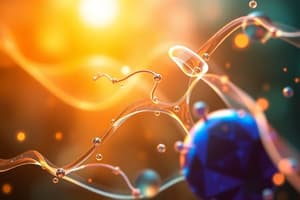Podcast
Questions and Answers
What is a characteristic of an isolated system?
What is a characteristic of an isolated system?
- It cannot exchange matter or energy with its surroundings. (correct)
- It can exchange matter with its surroundings.
- It can exchange energy with its surroundings.
- It can exchange both matter and energy with its surroundings.
What is the primary role of Gibbs free energy in chemical reactions?
What is the primary role of Gibbs free energy in chemical reactions?
- It determines the rate of the reaction.
- It determines the entropy of the reaction.
- It determines the equilibrium constant of the reaction.
- It determines the feasibility of the reaction. (correct)
What is the primary factor that determines the feasibility of a biochemical reaction?
What is the primary factor that determines the feasibility of a biochemical reaction?
- The change in enthalpy (ΔH) of the reactants and products
- The change in entropy (ΔS) of the reactants and products
- The change in free energy (ΔG) of the reactants and products (correct)
- The difference in the concentrations of the reactants and products
Under standard conditions, what is the relationship between ΔG and ΔG°?
Under standard conditions, what is the relationship between ΔG and ΔG°?
What is the difference between ΔG and ΔG°?
What is the difference between ΔG and ΔG°?
What is the implication of a negative ΔG value for a reaction?
What is the implication of a negative ΔG value for a reaction?
What is the significance of the sum of individual ΔG values for a biochemical pathway?
What is the significance of the sum of individual ΔG values for a biochemical pathway?
What is the relationship between ΔG and the equilibrium constant (Keq)?
What is the relationship between ΔG and the equilibrium constant (Keq)?
What is the relationship between the free energy change of the forward and reverse reactions?
What is the relationship between the free energy change of the forward and reverse reactions?
What is the condition required for a biochemical reaction to be feasible?
What is the condition required for a biochemical reaction to be feasible?
What is the consequence of the second law of thermodynamics on the total entropy of a system?
What is the consequence of the second law of thermodynamics on the total entropy of a system?
What is the significance of a positive ΔG value for a biochemical reaction?
What is the significance of a positive ΔG value for a biochemical reaction?
What is the primary reason why metabolism enzymes lower the barriers to ATP hydrolysis?
What is the primary reason why metabolism enzymes lower the barriers to ATP hydrolysis?
Which type of metabolic reaction is characterized by the formation of complex molecules from simple ones?
Which type of metabolic reaction is characterized by the formation of complex molecules from simple ones?
What is the term for the process of donating electrons in a redox reaction?
What is the term for the process of donating electrons in a redox reaction?
How can a redox reaction be rewritten to better understand its components?
How can a redox reaction be rewritten to better understand its components?
What is the term for the process of accepting electrons in a redox reaction?
What is the term for the process of accepting electrons in a redox reaction?
What is the primary function of enzymes in biological systems?
What is the primary function of enzymes in biological systems?
How do biological systems overcome the energy barriers of reactions with positive ∆G values?
How do biological systems overcome the energy barriers of reactions with positive ∆G values?
What is the role of ATP in the first step of Glycolysis?
What is the role of ATP in the first step of Glycolysis?
Why are the terminal phosphate bonds in ATP considered 'high-energy'?
Why are the terminal phosphate bonds in ATP considered 'high-energy'?
What is the significance of the kinetic stability of ATP hydrolysis?
What is the significance of the kinetic stability of ATP hydrolysis?
What is the advantage of ATP's kinetic stability in its role as an energy coupler?
What is the advantage of ATP's kinetic stability in its role as an energy coupler?
What is the cell potential for the reaction Cu2++ e- → Cu+?
What is the cell potential for the reaction Cu2++ e- → Cu+?
What is the value of ΔG° for the reaction Fe2+ + Cu2+ ↔ Fe3+ + Cu+?
What is the value of ΔG° for the reaction Fe2+ + Cu2+ ↔ Fe3+ + Cu+?
What is the equation for ΔG for a reaction A → B, taking into account the concentrations of reactant and product?
What is the equation for ΔG for a reaction A → B, taking into account the concentrations of reactant and product?
What is the value of the equilibrium constant for the hydrolysis of Compound A to components B and C, given ΔG° = -3.496 KJ/mol at 25°C?
What is the value of the equilibrium constant for the hydrolysis of Compound A to components B and C, given ΔG° = -3.496 KJ/mol at 25°C?
What is the relationship between ΔG° for a reaction and the equilibrium constant Keq?
What is the relationship between ΔG° for a reaction and the equilibrium constant Keq?
Flashcards are hidden until you start studying



